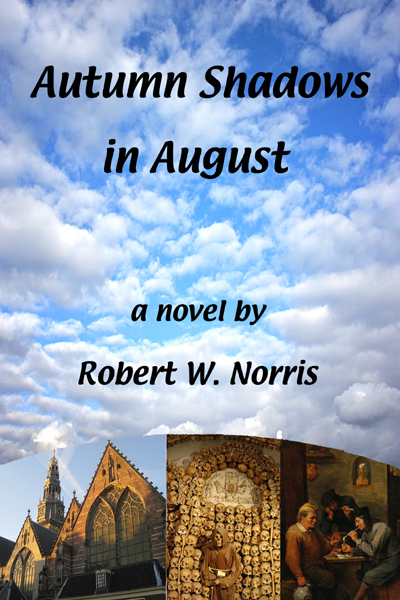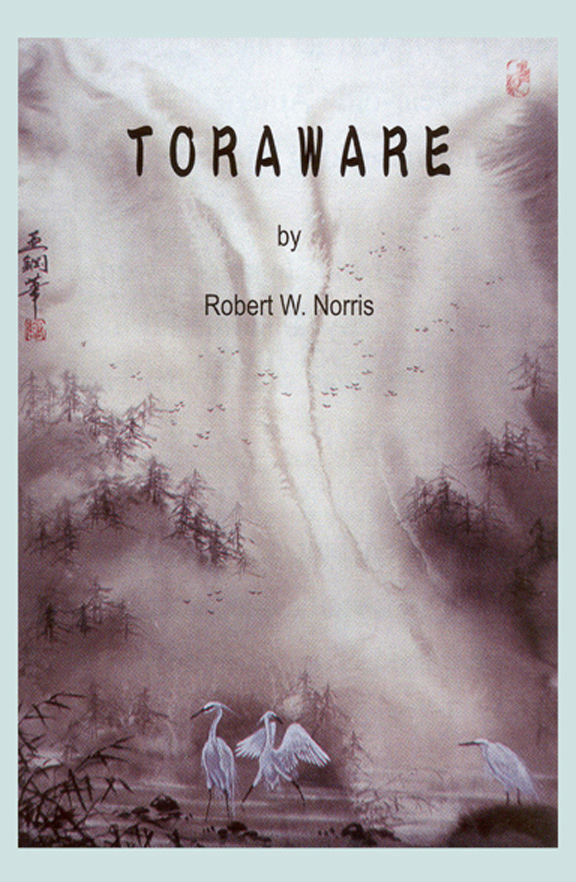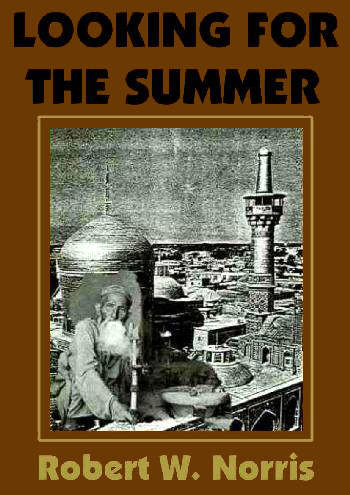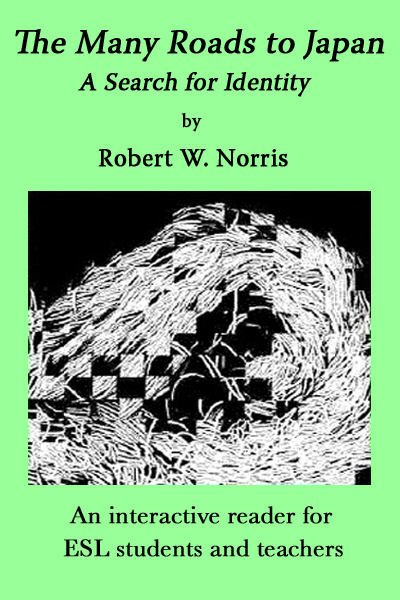
Home About Robert CV The Good Lord Willing and the Creek Don't Rise: Pentimento Memories of Mom and Me Novels Reviews ESL Papers (can be viewed online by clicking on titles) The Many Roads to Japan (free online version for ESL/EFL teachers and students) Contact     |
Robert
W. Norris - Curriculum Vitae
University History
May 1987 - Newport University, graduated with B.A. in Education (concentration in Teaching English as a Foreign Language) Sept.1992 - Newport University, graduated with M.A. in Education (concentration in Teaching English as a Foreign Language) Work History March 1983 to April '86: RIS American School (English Teacher) April 1986 to July '87: Seido Language Institute (English Teacher) Aug. 1987 to March '89: Kains English College (English Teacher) April 1989 to March '92: Kyushu Matsushita Electric (Training Center; English Teacher and Coordinator for English Program) April 1989 to March '92: Fukuoka Women's Jr. College; English Dept. (Part-Time Lecturer) April 1992 to March '98: Fukuoka Women's Jr. College; English Dept. (Full-Time Lecturer) April 1998 to April 2016: Fukuoka International University; International Communication Dept. (Associate Professor, 1998-2004; Professor, 2004-2016; Dean of Students from April 2004 to March 2006). Retired April 2016. At FIU, served on 3-5 committees every year from 2004 to 2016 -- chair of the International Exchange Committee, April 2007 to March 2009; chair of the Library Committee, April 2014 to March 2015; and chair of the FIU Journal Editorial Committee, April 2014 to March 2015. On April 1, 2018, Kyushu Gakuen (the board of directors for both Fukuoka International University and Fukuoka Women's Junior College) bestowed upon me the title of Professor Emeritus. Academic Associations May 1993 to 2016: Japan Association of Comparative Culture April 1996 to April 2004: Kyushu Academic Society of English Language Education June 1997 to 2016: Malamud Society of Japan April 2003 to 2016: International Ninomiya Sontoku Association. Novels 1.Looking for the Summer. 1996. Fukuoka: Touka Shobo. Republished 2004. New Jersey: Lulu Press. (A novel about a former Vietnam War conscientious objector's adventures and search for identity in Europe, Turkey, Iran, Afghanistan, Pakistan, and India in 1977.) 2. Toraware. 1998. Fukuoka: Touka Shobo. Republished 2006. New Jersey: Lulu Press. (A psychological probing of three very different characters who become deeply involved with one another near Kobe, Japan in the years 1983 to 1986 and whose lives are changed forever.) 3. Looking for the Summer (An E-Novel). 2000. Jacobyte Books. (A revised version of the earlier print edition) 4. Toraware (An E-Novel). 2000. Dead End Street Publications (A revised version of the earlier print edition.) 5. Autumn Shadows in August. 2006. New Jersey: Lulu Press (An expatriate's mid-life crisis/adventure, and homage to Hermann Hesse and Malcolm Lowry) Textbooks 1.The Many Roads to Japan: A Search for Identity. April 1,1997. Osaka: Osaka Kyoiku Tosho. Republished 2004. New Jersey: Lulu Press. (A novella and university textbook that tells the story of how one foreigner experienced many twists and turns in life before coming to Japan. Text by Norris; Japanese notes by K. Ichikawa, T. Ikeda, and S. Fukuda.) 2. The Many Roads to Japan: A Search for Identity (An interactive reader for ESL students and teachers). May 1, 2001. Self-published. (The same text as the original printed version, but without the Japanese notes. Developed as an HTML and PDF textbook for ESL students and teachers using the Internet as an educational resource.) 3. "Betonamu Sensou: Hansen ni Ikita Ai no Sugata." April 1998. In the Malamud Society of Japan's Amerika Eizou Bungaku ni Miru Ai to Shi (in Japanese, pp. 189-206). Tokyo: Hokuseido Shoten. (A detailed introduction to the movie Coming Home. Includes a summary of the story, the historical significance of 1968 in the U.S., and the background of Jane Fonda, the main actress.) 4. "The Children's Hour," "Julia," "Native Son," and "One Flew Over the Cuckoo's Nest." May 1, 1999. In Noguchi, K. and H. Yahiro (Eds.), Eiga de Tanoshimu Amerika Bungaku (in Japanese, pp. 64-71, 88-91, 144-147). Tokyo: Kinseido. (Brief summaries on the author, plot, differences between the movie and the book, background of the book, and key points of each of the above four literary stories.) 5. "Amerika no Chouheisei." March 2002. In the Malamud Society of Japan's Nichibei Eizou Bunka wa Sensou o Dou Mita Ka?: Wars in American and Japanese Movie Literature (in Japanese, pp. 165-172). Tokyo: Kinseido. (A description of the American draft registration system, who it affects, how it works, and what happens when it is implemented.) 6. Ronri Shikou wo Kitaeru Eibunn Raiteingu. Oct. 30, 2003. Tokyo: Kenkyusha. (Text written by Professor Tomioka; edited by Robert W. Norris. A guidebook developed to help Japanese develop more logical, coherent English sentences.) 7. Eigo Rashii Eibun o Kaku Tame no Sutairubukku. Sept. 20, 2006. Tokyo: Kenkyusha. (Text written by Professor Tomioka; edited by Robert W. Norris. A stylebook developed to help Japanese students and teachers develop more logical, coherent English sentences.) Published Research Papers 1."Errors, Humor, Depth, and Correction in the Eisakubun Class." 1992. In Cross Currents Vol. 19, No. 2: 192-195. (A presentation of a simple and effective error-marking system for English composition classes.) 2. "Raising Japanese Students' Consciousness of English Article Usage: A Practical View." 1992. In Fukuoka Women's Junior College Studies Vol. 44: 95-104. (A presentation of a possible solution for helping students overcome their problems in acquiring a working knowledge of the English articles "a" and "the.") 3. "Using Creative Dictation to Manage, Motivate, and Activate Large Groups of False Beginners." 1993. In Fukuoka Women's Junior College Studies Vol. 45: 71-82. (New ways of using an old technique. In a teacher-fronted class, most students are passive learners, but creative use of dictation can involve the entire class in many ways.) 4. "Teaching Reduced Forms: An Aid for Improving Lower-Level Students' Listening Skills." 1993. In Fukuoka Women's Junior College Studies Vol. 46: 49-56. (An examination of what changes take place in native speaker speech, the effects of stress and non-stress, and useful ideas for improving "bottom-up" processing skills.) 5. "Keeping up with Native Speaker Speed: An Investigation of Reduced Forms and Deletions in Informal Spoken English." 1994. In Studies in Comparative Culture, No. 25: 72-79. (What reduced forms and deletions are, how they are formed, implications for teaching, and tips for improving students' listening skills.) 6. "Getting Students More Personally Involved: An Alternative to the Yakudoku- and Lecture- Dominated Methods of Teaching Literature and Reading." 1994. In Fukuoka Women's Junior College Studies Vol. 48: 25-38. (An examination of the deficiencies of word-by-word translation and lecture-dominated teaching methods; a summary of current research on ESL/EFL reading; and suggestions for improving the teaching of literature and reading in Japanese colleges.) 7. "Getting Students More Personally Involved in Their Reading and Literature Classes: A Case Study." 1995. In Fukuoka Women's Junior College Studies Vol. 49: 35-48. (A detailed look at the planning rationale, the actual teaching, and the results obtained in a class taught in the manner prescribed in the previous paper.) 8. "Teaching Reduced Forms: Putting the Horse before the Cart." 1995. In English Teaching Forum, Vol. 33: 47-50. (The importance of presenting reduced forms to the students and giving the students practice in "bottom-up" processing before requiring them to engage in higher-level listening practice.) 9. "Introducing Discussion Skills to Lower-Level Students: Can It be Done?" 1996. In Bulletin of Fukuoka Women's Junior College Vol. 51: 21-32. (An examination of some key characteristics of Japanese communicative style; a summary of the current state of Communicative Language Teaching research; and a description of a step-by-step approach to introduce discussion skills to lower-level students.) 10. "Introducing Discussion Skills to Lower-Level Students: Practical Lesson Plans." 1997. In Bulletin of Fukuoka Women's Junior College Vol. 52: 9-23. (Based on the approach outlined in the previous paper, a series of detailed lesson plans are given for teaching basic discussion skills to lower-level students.) 11. "Cued, Form-Focused Dialogues: A Systematic Approach to Active Discussions." 1997. In Kyushu Academic Society of English Language Education, No.25: 139-142. (A presentation of a step-by-step approach to introduce discussion skills to lower-level students. The emphasis is on practical activities to be used in the classroom.) 12. "An Easy-to-Use Writing Program and Error-Marking System." 1999. In Bulletin of Fukuoka International University No. 1: 41-48. (A revised, updated, and more detailed presentation of paper number 1 listed above.) 13. "Civilian Public Service Conscientious Objectors in World War II." 2000. In Studies in Comparative Culture, No. 49. (An historical background of conscientious objection in the U.S and how it led to the formation of the CPS; the religious backgrounds of the men in the CPS and where they came from; the kind of work they had to do and where they had to do it; some of the problems they faced; what happened to them after the war was over; and their influence on subsequent generations) 14. "Learning to Think Backwards: Japanese Students and the Acquisition of English Relative Clauses." 2000. In Bulletin of Fukuoka International University No. 4: 41-47. (This first paper of a two-part series examines specific structural differences between English and Japanese RCs, summarizes research that has been done on Japanese learners' acquisition and production of English RCs, and proposes that consciousness-raising (CR) and "noticing" activities provide the most effective classroom instruction for Japanese learners at the university level. An explanation of the rationale behind the use of CR activities and why they are suitable for Japanese learners is also included.) 15. "Teaching Relative Clauses to Japanese University Students: Practical Lesson Plans." 2001. In Bulletin of Fukuoka International University No. 6: 35-45. (Based on the premises outlined in the previous paper, a series of detailed lesson plans are given for teaching relative clauses to Japanese university students.) 16. "How do We Overcome the Difficulties of Teaching Conditionals?" 2003. In Bulletin of Fukuoka International University No. 9: 39-50. (This paper examines the major difficulties inherent in the teaching and learning of English conditional sentences. Relevant research concerning the many types of conditionals, grammatical forms, semantic nuances, and frequency of usage is summarized, then followed by a proposed model for introducing "if" conditionals to ESL/EFL students.) 17. "Practical Lesson Plans for Teaching "If" Conditionals." 2003. In Bulletin of Fukuoka International University No. 10: 33-40. (Based on the earlier proposed model for introducing "if" conditionals to ESL/EFL students, this paper presents a variety of lesson plans for teaching these troublesome forms.) 18. "On the Difficulties of Classroom Management Faced by Foreign Teachers at Japanese Universities." 2004. In Dai 52 Kai Kyuushu Chiku Daigaku Ippan Kyouiku Kenkyuu Kyougikai Gijiroku (pp. 70-77). (This is the paper used for presentation number 13 listed below.) 19. "Some Thoughts on Classroom Management Problems Faced by Foreign Teachers at Japanese Universities." 2004. In Bulletin of Fukuoka International University No. 12: 23-30. (This paper examines examples of Japanese university student classroom behavior that often irritate foreign teachers, the characteristics of Japanese communicative style, and the role of the university in Japanese society. It concludes by suggesting some ways that foreign teachers can, in order to promote active learning, adapt their own cultural expectations in order to accommodate and take advantage of the expectations of their students. An extended and revised version of paper number 18 listed above.) 20. "Franklin Roosevelt and the Civilian Conservation
Corps." 2004. In Hotokugaku, No. 1: 94-97. (This
paper suggests "the spirit of altruism" as an
appropriate translation of Ninomiya Sontoku's houtoku
seishin. It also cites the CCC program as an
example of houtoku seishin in American history.)
21. "Dealing with Plagiarism at a
Japanese University: A Foreign Teacher's Perspective."
[PDF link] 2007. The East Asian Learner, Vol. 3,
No. 1: 1-20. (The first section of the paper covers my
experiences and difficulties in coping with an
increasing amount of plagiarism in my classes conducted
in Japanese. The next section summarizes the research I
did on the definition of plagiarism, on the question of
cultural influences, and on reasons students plagiarize.
The following section reviews recommendations and
measures that schools and researchers in the West are
trying to implement to combat the problem. The purpose
is to look for possible implications for the situation
in Japan. The final section discusses the results of my
reflective practice.) 22. "A Foreign Teacher's Thoughts on Plagiarism at a
Japanese University." 2007. In Bulletin of Fukuoka
International University No. 18: 1-12. (A modified
version of paper number 21 listed above.) 23. "A Comparison of
American GI Resistance to the Vietnam War and the Iraq
War." 2008. In Bulletin of Fukuoka
International University No. 20: 1-15. (This paper
makes a comparison of GI resistance to the Vietnam War
and the Iraq War. The first section examines the makeup
of the military in the two wars. The following sections
divide resisters into two types (disobedients and
dissidents) and examines the types of resistance they
have engaged in.) 24. "Introducing
Discussion Skills to Japanese University Students
Revisited (1): A Life Skills Education Perspective."
2014. In Bulletin of Fukuoka International
University No. 32: 1-16. (This paper examines
Fukuoka International University's (FIU) implementation
of a life skills education policy and its implications
for practical application in an English classroom. The
paper is divided into four parts. Part 1 discusses FIU's
Life Skills Education Policy; part 2 reviews the
research I did and recommendations I made in a two-part
series on teaching discussion skills in the 1990s; part
3 is a summary of relevant researcch related to the
teaching of crditical thinking and discussion skills in
Japan; and part 4 covers the rationale for the revision
of my teaching approach for a discussion skills class in
order to follow the new Life Skills Education Policy. It
also includes some introductory lesson plans for
teaching discussion skills.) 25. "Introducing Discussion Skills to Japanese University Students Revisited (2): More Practical Lessons." 2015. In Bulletin of Fukuoka International University No. 33: 1-14. ( Based on the ideas for implementing critical thinking elements into an English discussion skills class at a Japanese university outlined in the previous paper, this paper provides some comprehensive lesson plans for teaching basic discussion skills.) Online Articles 1. "The Internet: Promoting Around the World." 1999. In Spotlight Vol. 3, No. 7. (In this article, based on my own experience, I offer practical advice to other authors about how to use the Internet for promoting their books) 2. "E-publishing Saved My Books." 2001. In E-Book Ecstasy Vol. 1, No. 17. (In this article, I outline the process of how my two novels went from print-published books to electronically-published books. I also offer basic advice to other authors considering the e-publishing world.) 3. "E-Publishing and the Expatriate Author" 2001. In Worlds Apart Review. (In this article, I give practical advice to expatriate authors on how to go about finding, querying, negotiating, and dealing with electronic publishers) 4. "Where Have All the CO Soldiers Gone?" 2004. In The 3rd Page: Journal of Ongrowing Natures, Vol. 3. (A look at resistance within the military during the current Iraq War and during the Vietnam War.) Association and Other Presentations 1. Keeping up with Native Speaker Speed: An Investigation of Reduced Forms and Deletions in Informal Spoken English. Nov. 13, 1993. Presented at Japan Association of Comparative Culture--Kyushu Chapter. (A presentation on what reduced forms and deletions are, how they are formed, and some tips on how this knowledge can help students improve their listening skills.) 2. Conscientious Objection to the Vietnam War: A Look Back. Oct. 6, 1996. Presented at The Malamud Society of Japan--National Convention. (A description of the term "conscientious objection"; a brief summary of the history of conscientious objection in the U.S.; and an explanation of the role of conscientious objectors during the Vietnam War.) 3. Cued, Form-Focused Dialogues: A Systematic Approach to Active Discussions. Oct. 12, 1996. Presented at the Kyushu Academic Society of English Language Education. (A presentation of a step-by-step approach to introduce discussion skills to lower-level students. The emphasis was on practical activities to be used in the classroom.) 4. A Conscientious Objector's Story. Dec. 5, 1996. Presented to the English Literary Association at Japan Women's University. (The same lecture as that delivered on Oct. 6, 1996, but with more details provided from personal experience.) 5. The Many Roads to Japan: A Writer's Life Journey. July 24, 1998. An open-to-the-public lecture given at Fukuoka Women's Center in the Amikasu Building in Fukuoka. (In this lecture, given in Japanese, I talked about how I came to Japan and how I came to be a novelist. I also summarized the plots of my two novels.) 6. Silence and Alienation: The Psychological Scars of Incarceration. Dec. 5, 1998. Presented at the Dec. 1998 Malamud Society of Japan's Open Symposium. (As a panelist on the symposium -- which explored the theme of "Is it possible to read meaningfully about the literature of forced labor camps?" -- I talked about (a) the difficulties of readjusting to society experienced by those who have been incarcerated for their beliefs, nationality, or skin color and (b) the importance of appreciating what the artist had to undergo psychologically in order to create his or her work.) 7. American Conscientious Objectors in World War II: Who Were They? What Did They Do? What Happened to Them? June 12, 1999. Presented at the national conference for Japan Association of Comparative Culture. (The focus of this presentation was on the group of COs that participated in the Civilian Public Service program. The contents of the presentation included: a brief historical background of conscientious objection in the U.S and how it led to the formation of the CPS; the religious backgrounds of the men in the CPS and where they came from; the kind of work they had to do and where they had to do it; some of the problems they faced; what happened to them after the war was over; and a few words on their influence on subsequent generations.) 8. Samayoeru Tabi no Hate ni. June 20, 1999. Presented to Fukuoka Women's University Alumni Association. (This speech, given in Japanese, was basically the same as #5 above.) 9. Sekai o Tabi Shite no Shougai Gakushuu. March 12, 2000. Presented to Asakura Cho Machi Shougai Gakushuu Happyo Kai. (This lecture, given in Japanese, was about my conscientious objector experiences, travels to other countries, Japanese learning experiences, and the books I have published.) 10. Watashi no Jinsei de no Kotoba to Komyunikeishon no Taisetsusa. Dec. 4, 2000. Presented to Fukuoka Women's Junior College students at their Shakaijin Nyuumon program. (In this lecture, given in Japanese, I shared some stories about the importance of language and communication in my life. These stories included experiences with language and communication (1) as an antiwar soldier during the Vietnam War, (2) in my travels around the world, (3) as a student of Japanese, and (4) as a writer using the Internet.) 11. Aru Gaikokujin kara Mita Nihon Seikatsu no 20 Nenkan no Hakken to Bouken. Feb. 4, 2003. Presented to Chikushino-shi Kounen Daigakubu at the Chikushino-shi Shougai Gakushuu Center. (In this lecture, given in Japanese, I talked about the various discoveries and adventures I've had in my 20 years of living in Japan.) 12. Gurouburu Jidai ni Okeru Houtoku Shisou. April 15, 2003. Presented at the Inaugural International Ninomiya Sontoku Association Conference. (In this presentation, given in Japanese, I outlined an international group's rationale for studying the thought of Ninomiya Sontoku.) 13. Gaikokujin Kyoushi ga Chokumen Shiteiru Jugyou Kanri no Muzukashisa. Sept. 20, 2003. Presented at the 52nd Kyushu "Ippan Kyouiku Kenkyuu Kyougikai" Conference held at Nakamura Gakuen University. (In this presentation, given in Japanese, I took up the issue of the difficulties in classroom management faced by foreign teachers at Japanese universities.) 14. The Many Roads to Japan. Jan. 24, 2004. A special open-to-the-public lecture given at Kouchi University. (In this lecture, given in both Japanese and English, I talked about the Vietnam War, my experiences as a conscientious objector, the writing of The Many Roads to Japan, and the dispatch of Japanese Self Defense Forces to Iraq.) 15. Watashi wa Naze Tougoku wo Kakugo Shite Betonamu Sensou e no Sansen wo Kyohi Shita no ka. Feb. 29, 2004. Presented at the "Nihon Betonamu no Shimin no Rengo de Sekai Heiwa o Tsukuru Tame no Tsudoi" Assembly -- chaired by the writer/activist Makoto Oda; held in Ashiya; and sponsored by Kansai Citizens Opinion 30, Japan-Vietnam Citizens Exchange. (In this presentation, given in Japanese, I spoke about how I became a conscientious objector to the Vietnam War and chose prison rather than follow my military order to fight in the war.) 16. Jibun Sagashi no Tabi. June 20, 2004. Presented at the "Shuppan Kinen Kouen-kai" held at Fukuoka Asian Art Gallery for the author Tatsuo Sato. (In this presentation, given in Japanese, I spoke about how one's search for identity can be aided by the pursuit of expression, communication, and language study.) 17. Ruuseberuto Daitouryou to Nousanbutsu Antei Kousha. July 21, 2004. Presented at the "Kokusai Ninomiya Sontoku Shisou Gakkai Dai Nikai Gakujutsu Taikai" held at Tokyo-Aoyama Nihon Seinenkan. (In this presentation, given in Japanese, I spoke about possible English translations for Ninomiya Sontoku's houtoku seishin, and cited Franklin Roosevelt's Civilian Conservation Corps as an example of such in American history.) 18. Houtoku Shisou to Amerika no Senjuumin Shisou.
August 7, 2006. Presented at the "Kokusai Ninomiya
Sontoku Shisou Gakkai Dai Sankai Gakujutsu Taikai" held
at The College of Foreign Languages and Cultures, Dalian
University for National Minorities in Dalian, China. (In
this presentation, given in Japanese, I made a
comparison between Ninomiya Sontoku Thought and Native
American Thought.) 19. A Comparison of
American GI Resistance to the Vietnam War and the Iraq
War. March 22, 2008. Presented at Japan
Association of Comparative Culture -- Kyushu Chapter.
(In this presentation I made a comparison of GI
resistance to the Vietnam War and the Iraq War. The
first section examined the makeup of the military in the
two wars. The following sections divided resisters into
two types (disobedients and dissidents) and examined the
types of resistance they have engaged in.) 21. Jein Adamusu to Ninomiya Sontoku. August
26, 2010. Presented at the "Kokusai Ninomiya Sontoku
Shisou Gakkai Dai Go-kai Gakujutsu Taikai" held at Kyoto
Sangyo Daigaku. (In this presentation, given in
Japanese, I cited Jane Addams and her establishment of
the Hull House Settlement as an example of houtoku seishin in
American history.) Unpublished Research Paper 1. "The Use of Oral Proficiency Interviews as the Central Component of an In-Company Language Program." Sept. 1992. Thesis paper for an M.A. degree. (A detailed investigation into the pros and cons of using oral proficiency interviews to test and place students in a program with a large student population) Copyright (c) 2021 Robert W. Norris. All Rights Reserved
|